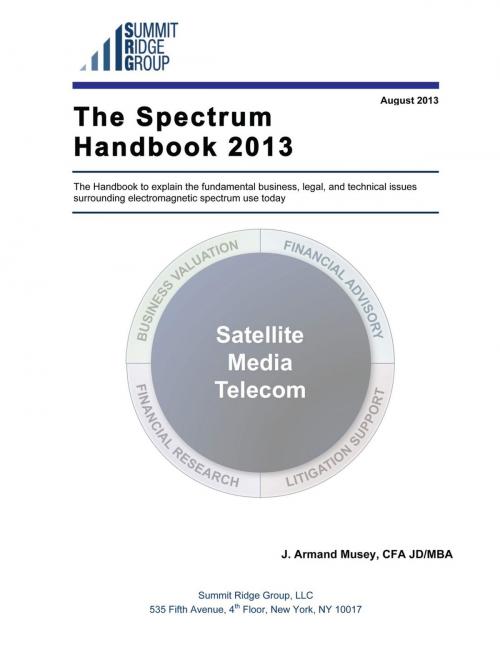The Spectrum Book 2013
Nonfiction, Reference & Language, Law, Communications, Science & Nature, Technology, Engineering, Business & Finance, Industries & Professions, Industries| Author: | J. Armand Musey | ISBN: | 9780989296212 |
| Publisher: | Summit Ridge Group, LLC | Publication: | August 15, 2013 |
| Imprint: | Summit Ridge Group, LLC | Language: | English |
| Author: | J. Armand Musey |
| ISBN: | 9780989296212 |
| Publisher: | Summit Ridge Group, LLC |
| Publication: | August 15, 2013 |
| Imprint: | Summit Ridge Group, LLC |
| Language: | English |
This Handbook has three objectives: 1) to serve as a primer for explaining the complex issues around the use of electromagnetic spectrum; 2) to analyze, from both an economic and a legal perspective, the regulatory processes being considered or underway to reallocate or change the use of spectrum bands; and 3) to be a reference source for industry professionals. Part I of the Handbook provides an overview of the spectrum and the regulatory process. Part II of the Handbook explains the various available spectrum bands, discussing their range, location, and physical properties and how these impact their ability to be used. An analysis of the current allocation of these spectrum bands in the United States follows. Part III contains detailed explanations of the various spectrum band plans. Throughout the Handbook, we provide links in the footnotes to sources for additional information. From a macro-perspective, regulators worldwide are currently reallocating spectrum from underutilized applications to the burgeoning mobile wireless broadband applications. Given the needs and importance of wireless broadband, from an economic and social perspective, this trend is likely unstoppable. The FCC is allocating both licensed spectrum (including the broadcast incentive auction) and unlicensed spectrum (including the 3.5 GHz and 5 GHz processes). Unlicensed (shared) spectrum is one approach to minimize disruption from these reallocation efforts and expand utilization is the small but significant spectrum sharing movement. Spectrum sharing is simultaneously proposing to improve spectral efficiency and calling into question the need for licenses altogether. As a result of the existing processes underway to improve the efficiency of spectrum allocation along with new technologies that further improve efficiency, the extent of "spectrum crunch" (i.e. the apparent lack of available spectrum) is poorly understood and hotly debated. Summit Ridge Group does not believe it is likely to bring information access to a grinding halt in the United States. Rather, we may see temporary congestion while regulators approve new reallocations of spectrum and spectrum-sharing plans, and service providers build out services on new spectrum. These processes, combined with wireless carriers' improved ability to regulate customer data usage-primarily by charging higher fees and/or capping usage, and offloading traffic via Wi-Fi and other technologies-should allow operators to continue to provide reliable service in the face of increasing demand. These trends are also likely to temper the increase in spectrum prices in the future.
This Handbook has three objectives: 1) to serve as a primer for explaining the complex issues around the use of electromagnetic spectrum; 2) to analyze, from both an economic and a legal perspective, the regulatory processes being considered or underway to reallocate or change the use of spectrum bands; and 3) to be a reference source for industry professionals. Part I of the Handbook provides an overview of the spectrum and the regulatory process. Part II of the Handbook explains the various available spectrum bands, discussing their range, location, and physical properties and how these impact their ability to be used. An analysis of the current allocation of these spectrum bands in the United States follows. Part III contains detailed explanations of the various spectrum band plans. Throughout the Handbook, we provide links in the footnotes to sources for additional information. From a macro-perspective, regulators worldwide are currently reallocating spectrum from underutilized applications to the burgeoning mobile wireless broadband applications. Given the needs and importance of wireless broadband, from an economic and social perspective, this trend is likely unstoppable. The FCC is allocating both licensed spectrum (including the broadcast incentive auction) and unlicensed spectrum (including the 3.5 GHz and 5 GHz processes). Unlicensed (shared) spectrum is one approach to minimize disruption from these reallocation efforts and expand utilization is the small but significant spectrum sharing movement. Spectrum sharing is simultaneously proposing to improve spectral efficiency and calling into question the need for licenses altogether. As a result of the existing processes underway to improve the efficiency of spectrum allocation along with new technologies that further improve efficiency, the extent of "spectrum crunch" (i.e. the apparent lack of available spectrum) is poorly understood and hotly debated. Summit Ridge Group does not believe it is likely to bring information access to a grinding halt in the United States. Rather, we may see temporary congestion while regulators approve new reallocations of spectrum and spectrum-sharing plans, and service providers build out services on new spectrum. These processes, combined with wireless carriers' improved ability to regulate customer data usage-primarily by charging higher fees and/or capping usage, and offloading traffic via Wi-Fi and other technologies-should allow operators to continue to provide reliable service in the face of increasing demand. These trends are also likely to temper the increase in spectrum prices in the future.















